The LED strobe control terminals supply an LED with the desired current and voltage. Applications from continuous light to short light pulses in the kHz range are thus possible.
More about this video
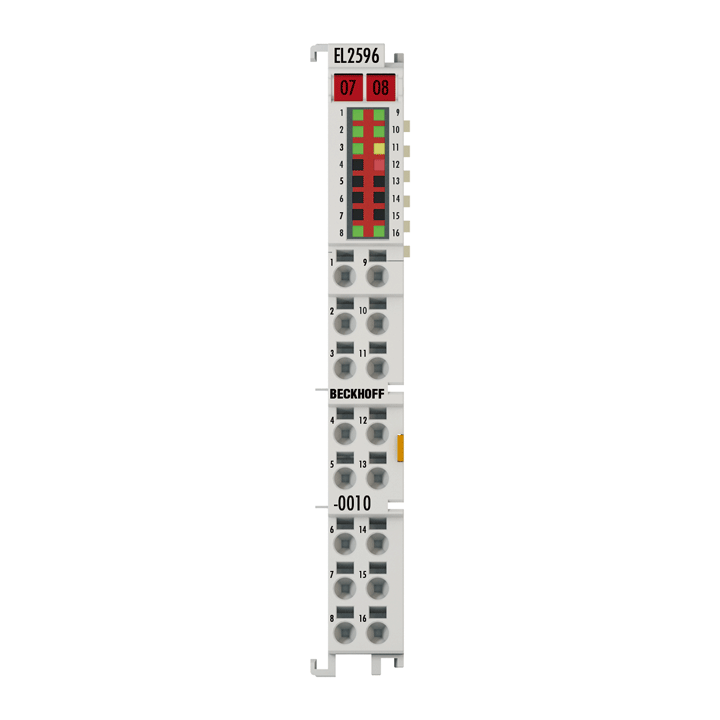
EL2596-0010 | EtherCAT Terminal, 1-channel LED output, 0…48 V DC, 3 A
The EL2596-0010 LED strobe control terminal contains a flexible power supply unit that supplies the LED with the required current and voltage. Applications from continuous light to short light pulses in the kHz range are thus possible. Each individual flash can be triggered in a controlled manner by the control system via the distributed clocks/timestamp function. The EL2596-0010 has a trigger output for triggering cameras and high-quality, fast current and voltage control, so that line scan cameras, for example, also benefit from constant illumination. Extensive real-time diagnostics, e.g. for input current/voltage and output current/voltage allow detailed monitoring of the LED light intensity. Thus, overdrive applications with short high-current pulses through the LED are possible. If a specifiable load corridor is exited, e.g., due to load errors, the EL2596-0010 switches off to protect the LED (resettable).
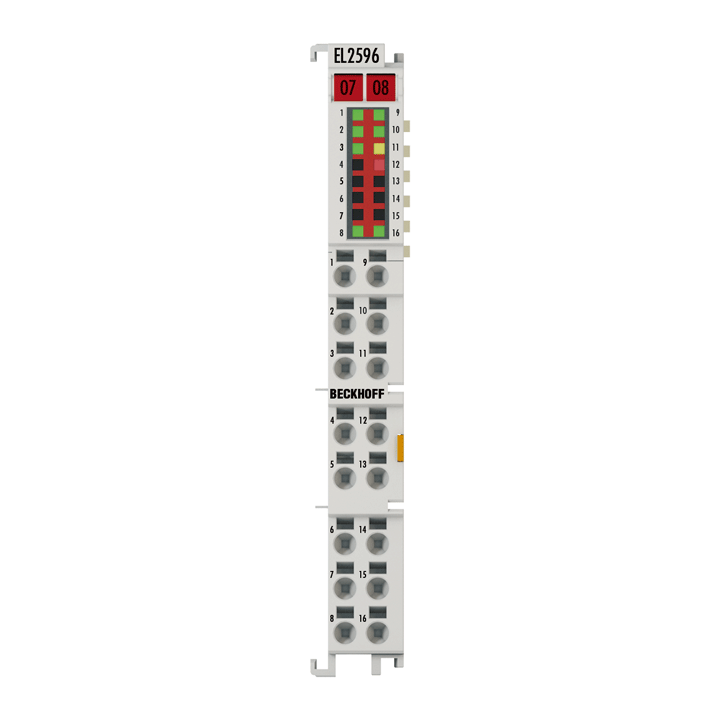
EL2596 | EtherCAT Terminal, 1-channel LED output, 0…24 V DC, 3 A
The EL2596 LED strobe control terminal contains a flexible power supply unit that supplies the LED with the required current and voltage. Applications from continuous light to short light pulses in the kHz range are thus possible. Each individual flash can be triggered in a controlled manner by the control system via the distributed clocks/timestamp function. The EL2596 has a trigger output for triggering cameras and high-quality, fast current and voltage control, so that line scan cameras, for example, also benefit from constant illumination. Extensive real-time diagnostics, e.g. for input current/voltage and output current/voltage allow detailed monitoring of the LED light intensity. Thus, overdrive applications with short high-current pulses through the LED are possible. If a specifiable load corridor is exited, e.g., due to load errors, the EL2596 switches off to protect the LED (resettable).
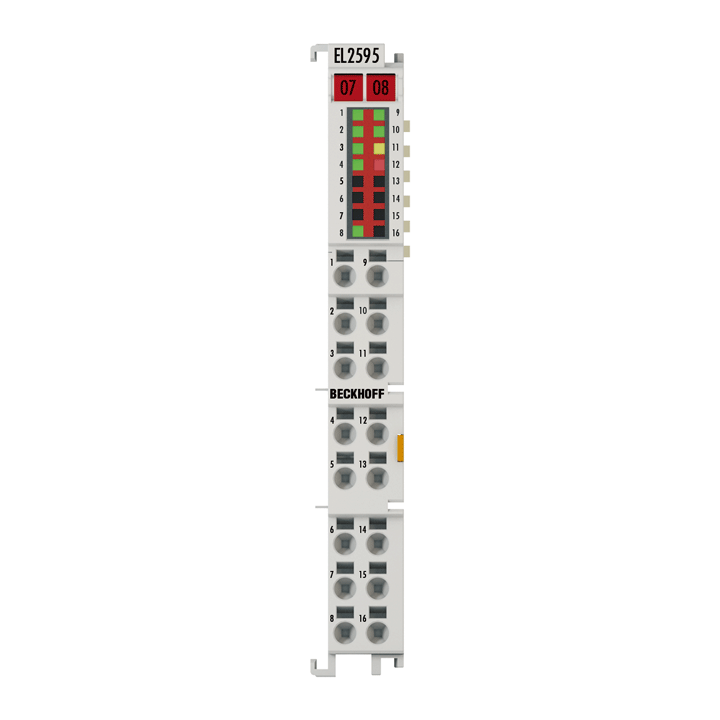
EL2595 | EtherCAT Terminal, 1-channel LED output, 2…48 V DC, 0.7 A
The EL2595 EtherCAT Terminal contains a constant current source for LEDs and is designed to control one or more LEDs connected in series. The user specifies the required set current, the integrated power supply unit then provides the required forward voltage, depending on the connected LEDs. For this purpose, the EL2595 has a step-up/step-down power supply unit, which generates the output voltage from the 24 V DC input voltage. The output voltage is also adjusted during operation in order to maintain the set current. The current can be switched quickly for short-term lighting, hence even extremely short flashes of light are possible. The pulse duration is adjustable from 1 µs to infinity, the flash time itself can be set through a timestamp via distributed clocks; an external trigger input is also available. Extensive real-time diagnostics, e.g. for input current/voltage and output current/voltage allow detailed monitoring of the LED light intensity. If a specifiable load corridor is exited, e.g., due to load errors, the EL2595 switches off to protect the load (resettable).
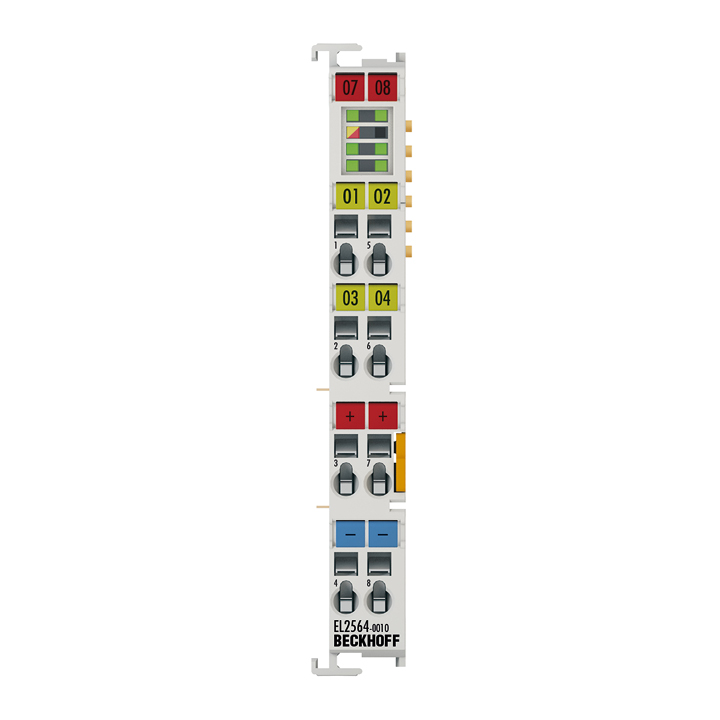
EL2564-0010 | EtherCAT Terminal, 4-channel LED output, 8…48 V DC, 3 A, RGBW, common cathode
The EL2564-0010 digital output terminal controls LEDs with integrated series resistor via an adjustable (ground switching) PWM signal. Common anode RGBW LEDs can be controlled with the four channels. The operation with four LEDs of the same color is also possible with the terminal. The terminal has a flexible input voltage of 8…48 V DC. The output voltage corresponds to the input voltage. For the operation of multicolor LEDs the color portion per channel is adjustable. Thus any color mix can be realized. In addition to the color mixing per channel, the adjustment of the total brightness over all channels is also possible. Another parameter that can be adjusted is the frequency. By setting the frequency in a range of 1…16,000 Hz, stroboscopic effects can be avoided. Furthermore, visible flashes can be realized by the low frequencies.
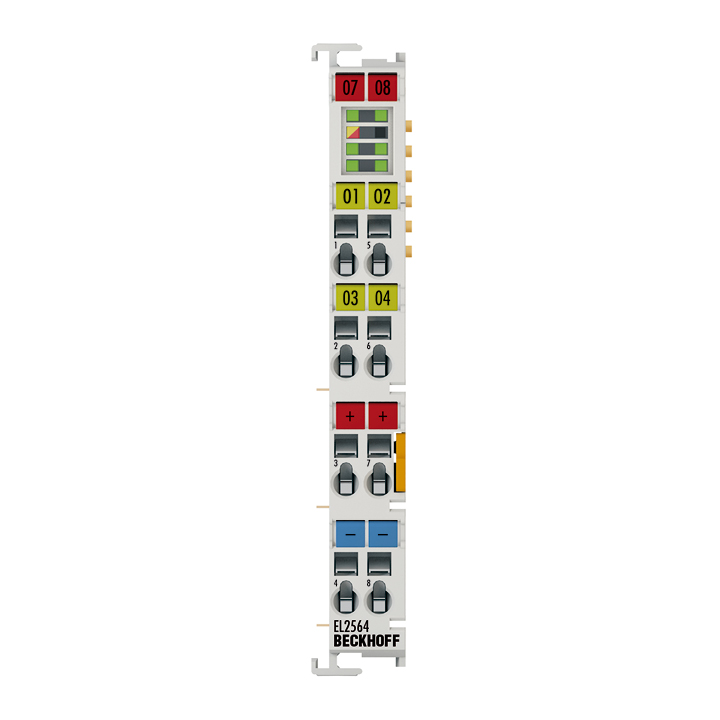
EL2564 | EtherCAT Terminal, 4-channel LED output, 5…48 V DC, 4 A, RGBW, common anode
The EL2564 digital output terminal controls LEDs with integrated series resistor via an adjustable (ground switching) PWM signal. Common anode RGBW LEDs can be controlled with the four channels. The operation with four LEDs of the same color is also possible with the terminal. The terminal has a flexible input voltage of 5…48 V DC. The output voltage corresponds to the input voltage. For the operation of multicolor LEDs the color portion per channel is adjustable. Thus any color mix can be realized. In addition to the color mixing per channel, the adjustment of the total brightness over all channels is also possible. Another parameter that can be adjusted is the frequency. By setting the frequency in a range of 1…16,000 Hz, stroboscopic effects can be avoided. Furthermore, visible flashes can be realized by the low frequencies.
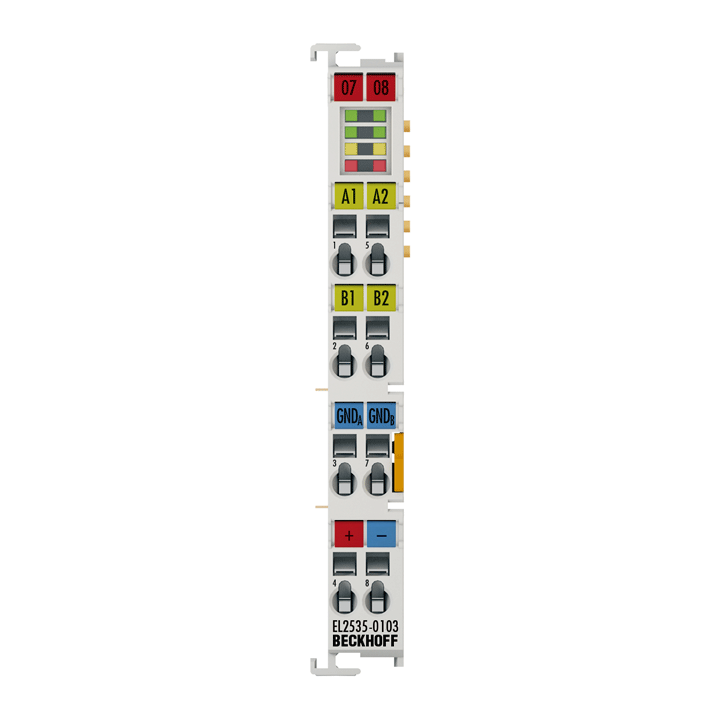
EL2535-0103 | EtherCAT Terminal, 2-channel PWM output, 24…48 V DC, 3 A, current-controlled
The EL2535-xxxx output terminals control the output current through pulse width control of the supply voltage. They are electrically isolated from the E-bus. The current values (0 to maximum output current) are specified by the automation device through a 16-bit value. The output stages are protected against overload and short circuit. Each EtherCAT Terminal contains two channels whose signal state is indicated by LEDs. The light emitting diodes simplify local diagnosis by displaying typical load and wiring faults.
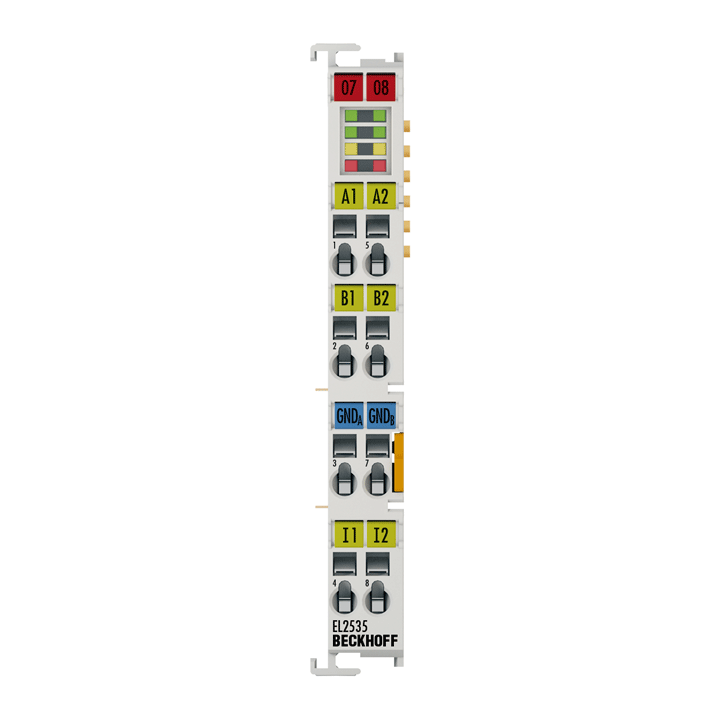
EL2535-0100 | EtherCAT Terminal, 2-channel PWM output, 24 V DC, 0.1 A, current-controlled
The EL2535-xxxx output terminals control the output current through pulse width control of the supply voltage. They are electrically isolated from the E-bus. The current values (0 to maximum output current) are specified by the automation device through a 16-bit value. The output stages are protected against overload and short circuit. Each EtherCAT Terminal contains two channels whose signal state is indicated by LEDs. The light emitting diodes simplify local diagnosis by displaying typical load and wiring faults.

EL2535-0050 | EtherCAT Terminal, 2-channel PWM output, 24 V DC, 50 mA, current-controlled
The EL2535-xxxx output terminals control the output current through pulse width control of the supply voltage. They are electrically isolated from the E-bus. The current values (0 to maximum output current) are specified by the automation device through a 16-bit value. The output stages are protected against overload and short circuit. Each EtherCAT Terminal contains two channels whose signal state is indicated by LEDs. The light emitting diodes simplify local diagnosis by displaying typical load and wiring faults.
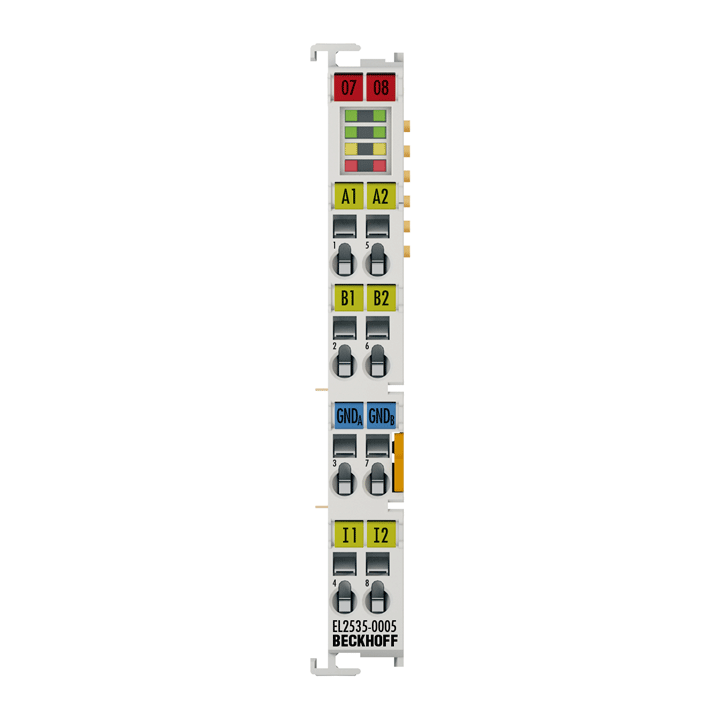
EL2535-0005 | EtherCAT Terminal, 2-channel PWM output, 24 V DC, 5 A, current-controlled
The EL2535-0005 output terminal controls the output current via pulse width control of the supply voltage. It is electrically isolated from the E-bus. The current values (0 to 5 A maximum output current) are specified by the automation device through a 16-bit value. The output stage is protected against overload and short-circuit. The EtherCAT Terminal contains two channels whose signal state is indicated by LEDs. The light emitting diodes simplify local diagnosis by displaying typical load and wiring faults.

EL2535-0002 | EtherCAT Terminal, 2-channel PWM output, 24 V DC, 2 A, current-controlled
The EL2535-xxxx output terminals control the output current through pulse width control of the supply voltage. They are electrically isolated from the E-bus. The current values (0 to maximum output current) are specified by the automation device through a 16-bit value. The output stages are protected against overload and short circuit. Each EtherCAT Terminal contains two channels whose signal state is indicated by LEDs. The light emitting diodes simplify local diagnosis by displaying typical load and wiring faults.

EL2535 | EtherCAT Terminal, 2-channel PWM output, 24 V DC, 1 A, current-controlled
The EL2535-xxxx output terminals control the output current through pulse width control of the supply voltage. They are electrically isolated from the E-bus. The current values (0 to maximum output current) are specified by the automation device through a 16-bit value. The output stages are protected against overload and short circuit. Each EtherCAT Terminal contains two channels whose signal state is indicated by LEDs. The light emitting diodes simplify local diagnosis by displaying typical load and wiring faults.
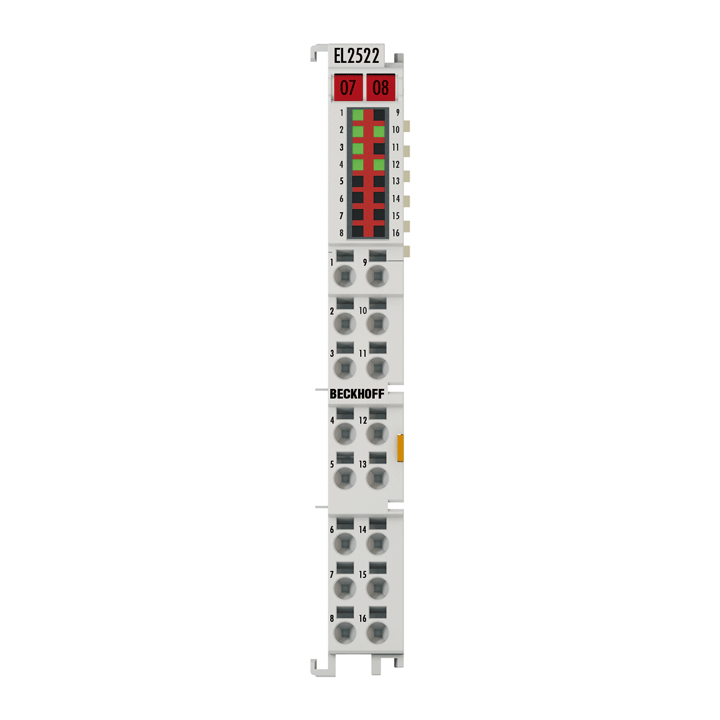
EL2522 | EtherCAT Terminal, 2-channel pulse train output, incr. enc. simulation, RS422, 50 mA
The EL2522 incremental encoder simulation terminal (pulse train) outputs a frequency-modulable signal on two channels with four outputs. The signal can be used to control motor drivers or other signal receivers, which are controlled by single cycles. The pulse sequence and pulse number can be specified directly via the process data in the frequency. Alternatively, the integrated path control can be used. For each channel the operating mode (frequency modulation, pulse/direction specification and incremental encoder simulation) can be selected. In addition, the EtherCAT Terminal can control three output channels in the ABC encoder simulation.
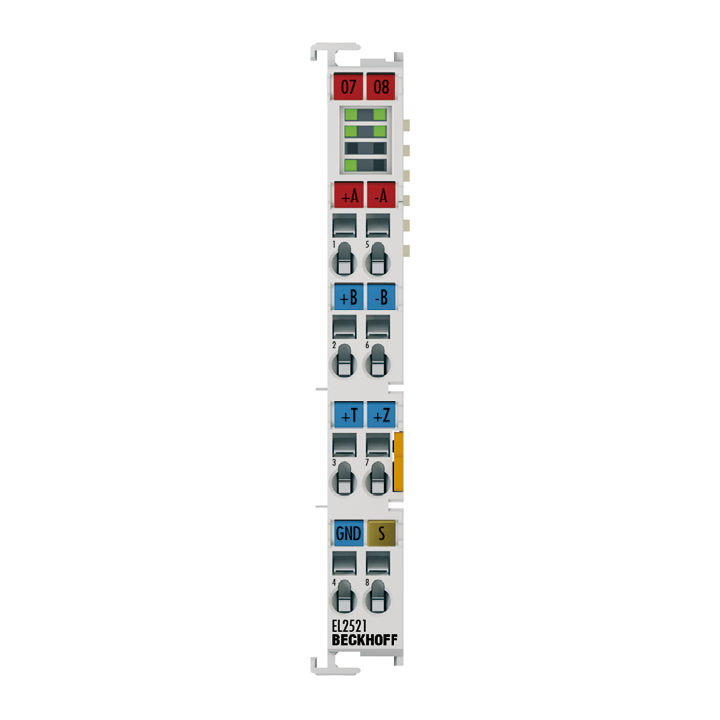
EL2521 | EtherCAT Terminal, 1-channel pulse train output, incr. enc. simulation, RS422, 50 mA
The EL2521-xxxx output terminals change the frequency of a binary signal and output it (electrically isolated from the E-bus). The frequency is preset by a 16 bit value from the automation device. The signal state of the EtherCAT Terminal is indicated by light emitting diodes. The LEDs are clocked with the outputs and each displays an active output.
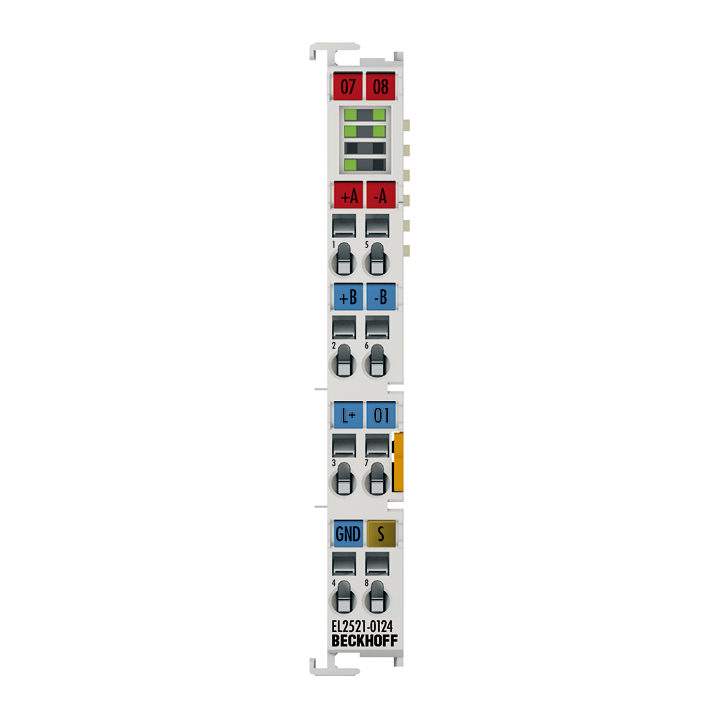
EL2521-0124 | EtherCAT Terminal, 1-channel pulse train output, incr. enc. simulation, 24 V DC, 1 A, with capture/compare input/output
The EL2521-xxxx output terminals change the frequency of a binary signal and output it (electrically isolated from the E-bus). The frequency is preset by a 16 bit value from the automation device. The signal state of the EtherCAT Terminal is indicated by light emitting diodes. The LEDs are clocked with the outputs and each displays an active output.
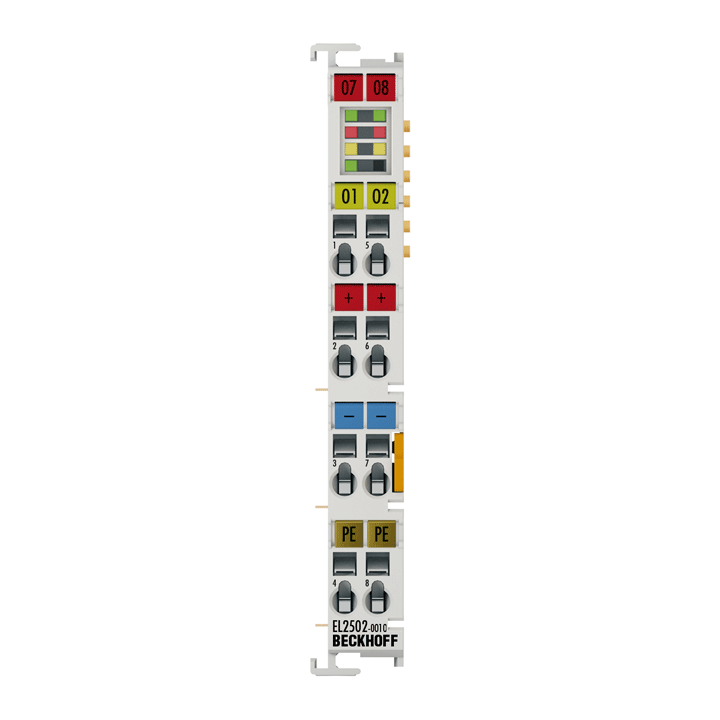
EL2502-0010 | EtherCAT Terminal, 2-channel PWM output, 24 V DC, 0.5 A, timestamping
The EL2502-0010 output terminal modulates the pulse width of a binary signal, and outputs it electrically isolated from the E-bus. The mark/space ratio is preset by a 16-bit value from the automation device. The output stage is protected against overload and short-circuit. The EtherCAT Terminal contains two channels whose signal state is indicated by LEDs. The LEDs are driven in time with the outputs, and show the duty factor by their brightness. The EL2502-0010 supports EtherCAT distributed clock timestamps in order to influence switching on, off and over of a PWM signal with microsecond precision.
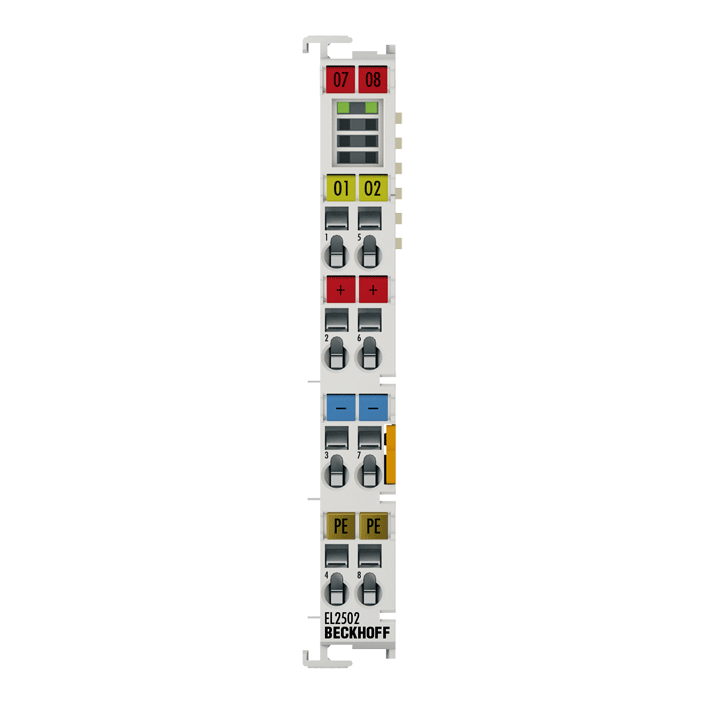
EL2502 | EtherCAT Terminal, 2-channel PWM output, 24 V DC, 0.5 A
The EL2502 output terminal modulates the pulse width of a binary signal, and outputs it electrically isolated from the E-bus. The mark/space ratio is preset by a 16-bit value from the automation device. The output stage is protected against overload and short-circuit. The EtherCAT Terminal contains two channels whose signal state is indicated by LEDs. The LEDs are driven in time with the outputs, and show the duty factor by their brightness.